Home of the Infantry Regiments of Berkshire and Wiltshire
THE (DUKE OF EDINBURGH'S) WILTSHIRE REGIMENT 1881-1920
THE WILTSHIRE REGIMENT (DUKE OF EDINBURGH'S) 1920-1959
1881 Cardwell Reforms
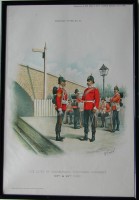
The Wiltshire Regiment at Devizes Railway Station.
Under the Cardwell reforms of 1881, the 62nd (Wiltshire) Regiment was linked with the 99th (Duke of Edinburgh’s) Regiment becoming respectively the 1st and 2nd Battalions of the (Duke of Edinburgh’s) Wiltshire Regiment. A Regimental Depot was established at Le Marchant Barracks, Devizes. After the campaign against the Zulus the regiment did not see any major actions until the start of the Boer War. The 1st Battalion spent the next fourteen years at home the 2nd Battalion spending the same time abroad. The 2nd Battalion served in South Africa, India (Rawalpindi, Peshawar, Nowshera, Cherat, Ambala, and Mean Meer), followed by several years in Burma.
1899 The Boer War
The 1st Battalion did not take part in the Boer War. Serving in Aden at the time of amalgamation it continued the usual routine of postings in Britain, Ireland and India, where in 1905 it was said that the Queens and the Wiltshire’s were the best two battalions in India. They remained there until 1909 when it moved to South Africa for five years. It returned to England in 1913.
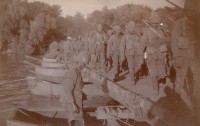
2nd Battalion crossing a pontoon bridge during a march during the Boer War.
The 2nd Battalion, the old 99th Regiment, was in South Africa at the time of amalgamation, and after postings to India, England and the Channel Islands returned there to take part in the Boer War, fighting in all the major engagements. The Mounted Infantry sailed in October 1899, ahead of the rest of the Battalion which followed two months later. Having landed at Port Elizabeth on 12th January 1900 the remainder of the 99th hurriedly went up country to join General French’s Force, engaged in holding up a threatened Boer invasion of Cape Colony. On 25th of January they were in action near Colesburg, taking part in a reconnaissance-in-force at Reitfontein. In February the Wiltshires joined the 12th Brigade, which included a half battalion of the Royal Berkshire, engaged in holding the left wing of the Colesberg position with 1,700 men against 6,000 Boers. For three days they held out and then withdrew though Rensburg to Arundel, where after a stiff fight two companies where cut off and surrounded by 800 Boers. Eventually 57 were killed or wounded, 91 captured, only three getting away.
On 23 July half the Battalion marched to support an attack on Slabberts Nek, a key position in the Wittebergen mountains. Precipitous rocks held up the left flank and the Wiltshires attempting to turn the Boers’ left flank, encountered a deep ravine, backed by a rugged cliff and heavy enemy fire. Next day the Wiltshires, led by Captain Bolton along a goat track on the side of a precipice in fog, went right round the enemy’s left flank, coming in behind the Boers who departed in a hurry. At the end of July whilst acting as Advanced Guard to a force which fought all day at Slap Krantz, a total of 6000 Boers were captured. A number of smaller actions from the blockhouses followed with the battalion remaining in contact with the enemy up to the Peace Conference in 1902.
A composite Company of Volunteers from the two Wiltshire Volunteer Battalions joined the 2nd Wiltshire’s in South Africa, and fought with them with great distinction. In 1901 the 3rd (Militia) Battalion arrived on St Helena for a year's duty as guards for the Boer Prisoners of War held there. When the war ended the 2nd Battalion returned to England in 1903 and spent time there and in Ireland before moving to Gibraltar in 1913.
1914 -1919 THE GREAT WAR – AN OVERVIEW
Following the Haldane army reforms in 1908 the 3rd Militia Battalion was transferred to the Special Reserve. At the same time the two Wiltshire Volunteer Battalions amalgamated to become the 4th Battalion the Wiltshire Regiment. During the war the 3rd Battalion trained drafts for overseas service and carried out home defence duties.
The 1st Battalion, being based in Tidworth at the outbreak of war, was mobilised at once and left for France on 13 August, taking part in the Battle of Mons 10 days later. The 2nd Battalion, recalled from Gibraltar, were in Belgium by 7 October and in action at Ypres soon after.
The misery of trench warfare and the catastrophic scale of losses that developed on the Western front during this war are well known, and the Wiltshire’s had their full share of both, In total 11 Wiltshire Battalions were raised, serving in France, Flanders, Italy, Salonika, Gallipoli, Mesopotamia and Palestine. The 4th (Territorial) Battalion was expanded and deployed on garrison duties in India. The 2nd/4th remained there for the duration, but the 1/4th left in 1917 for active duty as part of the Egyptian Expeditionary Force. In January 1919 the 1/4th moved to Port Said for garrison duty, then in April was ordered to the Sudan due to internal unrest there. The 3rd/4th served in England and Ireland as a Depot Battalion.
1914 The First World War
1st Battalion
In August 1914 the 1st Battalion were based at Tidworth and the 2nd Battalion at Gibraltar. The 4th (Territorial) Battalion were at their Annual Camp at Sling Plantation, on Salisbury Plain. On mobilization the 1st Battalion left for France on the 13 August, taking part in the battle of Mons 10 days later and followed by the retreat from Mons. The ‘retreat ‘was a fighting withdrawal with a number of significant actions fought along that route. The battalion remained intact and ended the retreat on the outskirts of Paris. Once the line stabilized the battalion took part in the First Battle of Ypres, and Neuve Chapelle by which time they had lost 26 officers and 1000 men, the equivalent of a whole battalion. This was followed by trench duty at Hooge and then Kemmel where they remained for the remainder of the year.
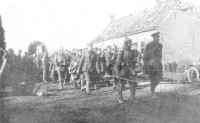
Colonel Forbes and what remained of the 2nd Battalion after capture at Reutel October 1914.
2nd Battalion
The 2nd Battalion mobilized on the 29th July 1914 when the ‘Alarm in Fortress’ was sounded in Gibraltar, sailing for England a month later. They landed at Zeebrugge as part of the 7th Division in October. Their initial deployment to defend Antwerp was abandoned after it was captured by the Germans. They redeployed to a position East of Ypres and very soon were in action at Reutel near Ypres. This first action for many was also their last as the battalion lost 450 men and 18 officers captured, 76 men and 7 officers were killed and 229 wounded after being assaulted by two complete German Regiments. After many other actions they ended 1914 in the line at Fleurbaix.
4th Battalion
The 4th Battalion mobilized and very quickly had sufficient men to form two battalions. The 1st /4th went to India in October 1914 to relieve regular battalions, followed quickly by the 2nd /4th. It was recognized nationally that the Army was far too small to meet the challenges ahead and under the leadership of Lord Kitchener, New Armies were raised. The County of Wiltshire quickly responded to the call.
5th & 6th (Service) Battalions
The 5th (Service) Battalion was raised at Assaye Barracks in Tidworth , August 1914. The numbers raised were too large so the 6th (Service) battalion was also raised from the 5th Battalion overspill of manpower.
7th (Service) Battalion
At the same time the 7th (Service) Battalion was raised at Marlbourgh by Lieutenant Colonel Rocke, a retired Wiltshire Regiment Officer.
1915 The First World War Continued
1st Battalion
The 1st Battalion spent the first few months on the Messines Ridge engaged in Trench warfare until March 1915. In March they took part in the Battle of Neuve Chapelle, followed by several more months in Trenches in the Dickebusch area. In June they took part in two attacks on the German Trench system round Hooge chateau, where the fighting was most severe. The next few months were spent in the trenches near Ypres, Hooge, alternating with rest periods in the ramparts at Ypres, itself under shell fire. In September they took part in a Major battle at Loos. In October together with the rest of their Brigade they were transferred to a New Army Formation, the 25th Division to provide experience. They spent the remainder of the year in the trenches at Ploegsteert Wood. Christmas dinner was not eaten until the 1st January 1916.
2nd Battalion
The 2nd Battalion started 1915 in the Fleurbaix area remaining in the waterlogged trenches when they were relieved by the Canadians in March. They were removed from the line to prepare for a major assault at Neuve Chapelle which started on the 9th of March. By the 14th March the battalion had suffered nearly 400 casualties. After a few days rest they returned to the line at Laventie where they resumed trench warfare. In May the battalion took part in the battle of Festubert where they suffered 158 casualties for one mile of ground taken. This was followed by a rest period in the Bethune area where they were reinforced. In June they were one of the leading battalions in the attack at Givenchy where after taking significant casualties the operation was cancelled. This was followed by many months of trench warfare in different sectors leading up to the Battle of Loos in September where their casualty figure was 400. Rest and reorganisation followed and in early December they were again redeployed to another Division, the 30th ending the year at Autheux.
1st & 2nd/4th Battalions
The 1st/4th and 2nd/4th spent 1915 in India on Garrison duties, but did supply a number of men as reinforcements to front line battalions in other theatres of operations.
5th Battalion
In July 1915 the 5th (Service) Battalion set sail for the Dardanelles and by the 17th were all ashore at Cape Helles, on the Gallipoli Peninsula. Two days later they were in the trenches facing the Turkish Army. On the 6th August they took part in a night attack to capture a ridge of hills to assist the British landing at Suvla bay. The following day they took part in the attack at Sari Bair. This was a successful attack, but the response was fast and very violent. They were attacked by a Turkish Division led by Mustapha Kemal. The battalion was overrun with half the battalion never being seen again. The battalion was reorganised, returning to trench warfare with the main enemy being dysentery and jaundice. On the 18th December they embarked for Mudros returning ten days later in a blizzard, here they saw in 1916.
6th Battalion
The 6th (Service) Battalion embarked for France in July 1915 as part of the 19th Division. They initially were introduced to trench warfare in the Laventie and Festubert area with their first attack taking place at Loos in September. After this battle they returned to the trenches in the Neuve Chapelle area where they ended the year of 1915.
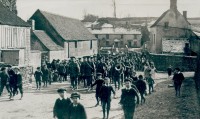
7th Battlion's Band marching through the village of Sherston on a recruiting drive.
7th Battalion
The 7th (Service) Battalion after training embarked for France 1000 strong in September spending two months in the trenches. In November they sailed to Salonika where their first task was to assist in constructing defences. They were engaged in this task at the end of 1915.
1916 The First World War Continued
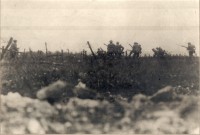
1st Battalion crossing No Man's Land at Thiepval 1916
1st Battalion
At the start of 1916 the 1st Battalion were in reserve at Papot. They remained here for three months when they went south spending three weeks near St Pol. After relieving the French at Vimy Ridge they spent two months engaged in trench warfare near La Targette. Unspectacular work but it still resulted in 82 casualties. In July the Battalion moved towards the Somme area. They did not take part in the attack on the 1st July but did go into action at Thiepval on the 4th. On the 22nd together with the 3rd Worcestershire Regiment they assaulted and captured the Lepzig Salient, including the Hindenburg trench. They withstood a number of counter attacks by the Prussian Guards all of which were beaten off. Other attacks followed together with more time spent in the trenches. In October they moved north and took up a position in the Ploegstreert where they were at the end of the year.
2nd Battalion
The 2nd Battalion started 1916 in the area of Amiens. They remained in this general area reliving units in trenches and training for an offensive that was going to take place in July. On the 1st July they were in support in the area of Montauban, followed by two days of attacks. They remained in this area for most of July. On the 8th July they played a leading part in the attack on Trones Wood and at one point bayoneted their way through what remained of the German defenders in the wood. They suffered 240 casualties in this action but were awarded plus 23 decorations for gallantry. Further attacks followed in the Somme and Flers areas and they ended the year just South of Arras.
1st/4th & 2nd/4th Battalions
The 1st/4th and 2nd/4th remained on Garrison duties in India.
5th Battalion
The 5th (Service) Battalion evacuated from Cape Helles in January going to Port Said where they were reinforced with 750 men. In February they went to Kuwait and in March to Amara via the Tigris River. They then relieved the Lahore Division south of Kut. In April they took part in the attempt to relieve Kut and attacked the Turkish Trenches at Hannah, followed by an attack on Sanna-I-Yat. All the efforts to relive Kut failed and eventually the garrison was forced to surrender. (Many men who had been transfered from the 1st and 2nd/4th Regiments in India were captured with units besieged in Kut) May was spent in defensive positions after which they returned to the Amara area where they remained until the end of December when they crossed the Hai River ready to move North to Kut.
6th Battalion
At the start of the year the 6th (Service) battalion were in the Neuve Chapelle area where they were engaged in trench warfare until April. After a period of strenuous training the battalion moved to Albert, on the River Somme in preparation for the forthcoming offensive. A week after the start of the Battle of the Somme they took part in the capture of La Boiselle, moving into Mametz Wood shortly after. At the end of August they were relieved in order to re-organize having suffered 380 casualties in two months. The rest of the year was spent in the line in the Kemmel sector, and on the River Ancre. Here they ended the year.
7th Battalion
The 7th (Service) Battalion at the beginning of the year were continuing their work on the defences. At the end of July they took over the trenches near Kalinova from the French. In this position they repulsed a number of attacks by the Bulgars. At the end of October the Battalion moved to the area of Doiran where they reverted to trench warfare. They were at this location at the end of 1916.
1917 The First World War Continued
1st Battalion
The 1st Battalion started the year in the area of Ploegsteert, being relieved mid January for a fortnights hard training. In February they carried out a daring daylight raid in conjunction with the 10th Cheshire’s. The raiders won six Military Medals. In late February they were relieved by New Zealand units, spending the next seven weeks training. This was required due the reorganization of all battalions whereby each platoon became self sufficient in terms of weapon capabilities. The Army was starting to move towards mobile tactics. In April they took over some trenches from the Australians near Plogsteert. They went in and out of the lines until the 7th June when the battalion took part in the attack on Messines Ridge. Two days later after hard fighting they had taken 148 prisoners and 7 machine guns, but they had sustained 170 casualties. One of the officers being awarded the Military Cross in this action was Captain R Hayward (Later to win the Victoria Cross). This was a significant action because in taking this high ground it improved the situation in the Ypres salient, which had been overlooked by the Germans for most of the war. In July they moved to Ypres and had their first taste of mustard gas. At the end of July they took part in the attack on Westhoek Ridge remaining in the area under heavy shell fire until the 5th August. After a short rest they returned to the Ridge to support other units under pressure from the Germans. On the 10th September they moved south to join the First Army moving into the Givenchy Sector, near Bethune where they took up a position in October remaining for two months. At the beginning of December they were transferred once again, this time to the Third Army, to the Laqnicourt Sector near Bapaume. They were at this location at the end of 1917.
2nd Battalion
The 2nd Battalion spent the first three months around Arras. On the 9th April they took part in the attack on the Hindenburg Line Very few men reached the objective and those that did found that the German wire was undamaged. On the 11th April they came out of the line weaker by 16 officers and 363 other ranks. After ten days rest they returned for a further weeks fighting in the same area. They then spent a month training before a long march north to the area of Ypres. For most of July they were in training. On the 31st July they took part in the Third Battle of Ypres near Hooge. In Late August they relieved the Australians on the newly capture Messines Ridge. They remained here for three months digging deeper and taking part in many trench raids. In November they moved to the Gheluvelt area, where they ended the year of 1917.
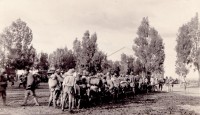
1st/4th Battalion - Turkish prisoners at Wilhabura in Palestine in 1917/18
In March 1917 the 1st/4th received orders and eventually left Bombay for Palestine and active service. After a long journey they joined the 75th Division in the trenches South of Turkish held Gaza. In November the battalion made their first attack in the third battle of Gaza capturing Outpost Hill, followed by Ali Muntar Hill and Fryers Hill. The Turks evacuated Gaza and were pursued towards Jerusalem with the battalion leading the pursuit. They were heavily committed during November with actions at El Mesmiyyeh and Kuryet-El-Enab just a few miles short of Jerusalem. The battalion were in reserve when Jerusalem was surrendered by the Turks. On the final day of 1917 the battalion was holding an outpost line at El Tireh.
2nd/4th Battalion
The 2nd/4th remained in India and in March 1917 moved to the Allahabad Brigade in the 8th (Lucknow) Division.
5th Battalion
The 5th (Service) battalion were in action on the 25th January 1917 when they assaulted the Turkish front line, one flank of which rested on the Hai River which they had crossed only a month before. They took heavy casualties in this action. On the 25th of February they crossed the River Tigris and by the end of the month after hard marching they were 40 miles short of Baghdad. On the 10th March they made a night river crossing over the Diala River establishing a bridgehead and taking 120 prisoners in the process. The way to Baghdad was open and the battalion was the first to enter the city. At the end of March the battalion advanced on Turkish positions 35 miles north of Baghdad near Daltawa. They sustained heavy casualties in this attack. . In April and May they continued the advance up the line of the River Adhaim with contact being made with the Russians operating from the Caspian Sea. They then took up defensive positions between the rivers Tigris and Adhaim, East of Samara. In early December they advanced towards Kara Tepe, with the battalion pursuing the Turks through Sakaltutan Pass. They paused at this point and ended the year reorganizing and training.
6th Battalion
Early in 1917 the 6th (Service) Battalion were in the line at Hebuterne, near Thiepval, moving to the Ypres salient in April. In June they took party in the successful attack on Messines Ridge, gaining all their objectives. A period of trench warfare was followed by heavy fighting on the Passchendaele Ridge. On the 20th September they captured and held a position in front of Hollebeke Chateau. Casualties were heavy and the battalion was reinforced by 25 officers and 350 other ranks of the Royal Wiltshire Yeomanry, who had been dismounted. They became the 6th (Royal Wiltshire) Yeomanry) Battalion. This arrangement worked well as many of the men in both units came from the same towns and villages in Wiltshire.
7th Battalion
The 7th (Service) Battalion started 1917 as they left the year before, in the trenches remaining there until April On the night of the 24th April they launched an attack at the Grand Couronne, coming up against devastating fire and un-breached wire. 14 out of the 15 officers became casualties, together with about 300 other ranks. The companies came under the command of Warrant Officers and Sergeants and the situation was likened to the Battle of Ferozeshah in 1845. After this battle they were in the line at Popovo, and then Smol. At the beginning of July they resumed training, retuning to the front line in August. The rest of the year was spent in Greece in the trenches with much patrolling.
1918 The First World War Continued
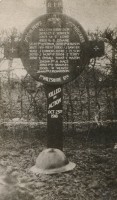
1st Battalion a memorial to twenty members who were killed in action on 23rd October 1918 in an attack on Ovillers
1st Battalion
The 1st Battalion started the year in the Laqnicourt sector, North East of Bapaume remaining there for two months. On the 21st March 1918 they were in reserve at Achiet-Le-Grand when the German Army launched a major offensive. The battalion were in contact with the enemy for the next six days during which Captain Hayward MC won the Victoria Cross. By the end of this period the battalion was reduced to Company strength. In Early April they were dug in forward of Ploegstreert Wood where they were again subjected to a heavy German attack which eventually captured the wood. The Battalion withdrew under heavy shell fire. They later took part in a Counter attack and for the second time in a month were reduced to one company due to casualties. At the end of April they received reinforcements, mainly from the disbanded 6th (service) Battalion and immediately took part in the successful attack on Kemmell Village on the Messines Ridge. Thereafter they remained in the trenches and on the 27th May they were ordered forward to assist the hard pressed 8th Division. They took up a position in front of Boufignereux. They were pushed back splitting up into small parties, fighting a rear guard action all the way. Over the following three weeks the battalion was spilt up fighting with other units ending up as part of the 1st/25th Composite Battalion. After a lot of fighting and general reorganisation they ended up a Thiepval at the end of July remaining there throughout August. On the 24th August attacked Miraumont Ridge then five days later led the advance towards Beaulencourt which was captured on the 1st September. They continued the advance beating of a determined attack on the 11th, followed by an attack on the 18th. The battalion were in action nearly every day. On the 5th October they crossed the canal at Bantouzelle and occupied part of the Hindenburg Line from where they attacked the Beaurevoir Line taking all their objectives. On the 23rd October they took part in a night attack on Ovillers. On the 6th November they attacked the village of Aulnoye which proved to be the last action for the battalion in the Great War. On the 11th November they were at Berlaimont on the Sambre.
2nd Battalion
In January 1918 the 2nd Battalion together with the rest of the 30th Division moved South to relieve the French and took up positions in the trenches South of St Quentin. In February they were out of the line preparing for a German offensive that was known to take place sometime in March In the middle of March they took over redoubts west of St Quentin On the 21st March the German attack stated and the battalion was very quickly out flanked and were soon completely surrounded. The battalion lost 22 officers and 600 other ranks. The battalion’s battlefield reinforcements were themselves engaged in a desperate rearguard action, not knowing what happened to their comrades. They joined a composite battalion. By April the battalion had been reformed and they were again fighting the Germans near Ypres. They later transferred to the 19th Division and absorbed some of the 6th Battalion after their disbandment. They then assisted in training the newly arrived Americans. They then came under the control of the French and took up positions on the River Marne. On the 29th May near Bligny whilst acting as outposts they came under severe German attack, whilst their comrades in the 1st Battalion were at Faverolles only five
miles away suffering the same fate. They fought for several days very nearly being encircled. Again casualties were heavy and they then formed part of a composite battalion known as the 58th. On the 7th June they withdrew after 10 days continuous fighting. In August they moved to the Loos sector by now fully up to strength again and moved into outposts in the Givenchy sector. Here they took part in trench raids On the 3rd September they attacked in the area of Neuve Chapelle being relieved on the 1st October. On the 20th October they captured Haussy sustaining about 120 casualties, unfortunally most of these were from British shells falling short. On the 4th November they captured the high ground in front of Eth, near Bavay. They were relived on the 9th November returning to Eth where they were resting on the 11th November 1918 at the cessation of hostilities.
1st/4th Battalion
They started the year holding an Outpost at El Tireh staying there for about a month. In March and April they conducted operations in the Wadi Ballet area between Rafat and Jerusalem. In April they carried out an attack East of Rafat sustaining 180 casualties, mostly wounded on the Sheikh Subih Ridge. They spent the next five months in the front line at Rafat and Berukin. The enemy was mainly dirt and flies. In September with the rest of the 75th Division they took part as the leading battalion in the assault on El Tireh. In this final attack of the war they lost their Commanding Officer plus three other officers, sixteen men, and sixty seven wounded. The village was captured. In December the battalion moved to Kantara on the Canal and in January 1919, to Port Said. The Regimental Cadre eventually reached Trowbridge in October.
2nd/4th Battalion
The Battalion returned to England at the end of the war and were disbanded in 1920. Many of the men serving in the battalion did not return as they were re-deployed to other units including some on the North West Frontier.
5th Battalion
The 5th (Service) Battalion spent from January to April in training and road building, and reconnaissance in the North –west of the Jebel Hamrin. On the 24th April they moved North to take part in operations on the Kifri front, and on the 29th drove the enemy from the hills near Tuzkurmati, which was captured with 1800 Turks. They remained as part of the garrison of Tuzkurmati till September. For the nest two months they took part in operations to push back the Turks in areas such as Kirkuk and Mosul. On the 1st November, Turkey signed an armistice, and the battalion returned to Kirkuk. They were demobilized at Amara, with the Regimental Cadre going to the North West Frontier of India as part of a composite Battalion. They reached Devizes in September 1919 where they were disbanded.
6th Battalion
The 6th (Service) Battalion were in the line in the Cambrai sector remaining until February. In March they were holding a position near Bapaume very close to the 1st Battalion. When the Germans attacked in March they took the full force of the attack and were heavily engaged for a week. They were forced back sustaining 20 officer and 500 other rank casualties. On the 1st April they moved to Locre where they received over 550 reinforcements. A week late they took up a position on the Messines Ridge and immediately came under attack in great strength. They partly withdrew with some companies being completely outflanked. At the beginning of this attack the battalion number 581, and by the end 181. On the 14th April after again being reinforced they relieved the South Africans at Spanbroek and once again immediately came under attack. On the 6th May the Battalion was disbanded, as were many other battalions when brigades were reduced from four battalions to three. One of the deciding factors was the battalion weakness in numbers. Most of the men were sent to the 2nd Battalion. In June the Battalion was reconstituted by absorbing the 9th Battalion, the Dorsetshire regiment and again took part in heavy fighting in the last stages of the war. They were disbanded in Devizes in 1919.
7th Battalion
The 7th (Service) Battalion were in Greece for the early months leaving for France in June. In July they joined the 50th Division near Dieppe. On the 3rd October they took up a position near Epehy, near the Somme. They attacked the following day taking 152 prisoners. A further attack on the 6th was not successful as the battalion were held up by barbed wire and sustained casualties of 5 officers and 217 other ranks. They later attacked at Le Cateau with the battalion being awarded 21 Military Medals. On the 7th November they took part in the final attack advancing near Landrecies taking all their objectives. They established bridgeheads across the River Sambre and when the Armistice was signed they were South of Maubeuge. They were finally disbanded in June 1919.
The Regiment earned 60 Battle Honours and many awards for gallantry were made. The 1st Battalion alone gained 6 MCs, 4 DCMs and 9 MMs in the last few days of fighting. Captain Reginald Hayward (already the holder of the Military Cross and Bar) was awarded the Victoria Cross in 1918 for continuing to lead his men and repel heavy enemy attacks on their portion of the trenches in spite of being injured several times, refusing to seek medical help until he collapsed from exhaustion. The cost in deaths was heavy with the Wiltshire’s nearly losing 5,000 men.
For a more detailed examination of what each battalion did in the First World War go to the War Diaries Section of this Web site.
1919 – 1939 Between the Wars
Both the 1st and 2nd Battalions demobilised quickly in France, leaving only a nucleus of regular soldiers who were back in England early in 1919. In July 1919 came the ‘Peace’ celebrations with big parades by the Allies in Paris and London. In both cities the 1st Battalions colours were carried by Lieutenants R.F.J. Hayward V.V., M.C., and S.J. Parker, M.C., D.C.M.
The 3rd (Special Reserve) Battalion was disbanded in late 1919. The 4th Battalion was also disbanded after the war, but then re-formed and grew in numbers, being presented with Colours in 1927. In 1920 the Regiment changed its title to The Wiltshire Regiment (Duke of Edinburgh’s).
Over the next 20 years a routine of one regular battalion abroad, the other at home training men and despatching drafts to the overseas battalion was established. Every three years or so there was a change of location, ending the practice of lengthy stays in one place.
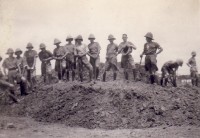
1st Battalion - Trench Digging on Outpost duty during the Sino-Japanese War at Shanghai, China in 1932.
After the war the 1st Battalion initially went to Ireland but were depleted in numbers due to the fact they supplied a company for the expedition to Russia where they became part of a Hampshire Battalion as part of the Russian Relief Force. This was part of a force protecting British interests during the Russian Revolution, fighting against the Bolsheviks. Whilst in Ireland they were engaged on internal security duties against Sinn Fein. Sport was an important element with the battalions gaining many victories, and the 1st Battalion winning the Army Association Football Cup in the 1923-4 season, in the presence of HM the King. They returned to England in 1922 remaining thee until 1930 when they sailed for Egypt. The following year they sailed for Shanghai where they took up defensive positions around the international settlement on the edge of the city. This was due to the ongoing hostilities between Japan and China. In 1932 they left for Malaya where they were garrisoned in Tanglin Barracks, Singapore. They went to Bangalore in India in 1936, and in 1939 they had new colours presented, but they were quickly placed in safety due to the out break of the Second World War.
After the War the 2nd Battalion initially went to Hong Kong with one company detached to Pekin, where they shared the duties of the Legation Guard with Detachments of the Americans, French, Italian, Japanese, Dutch and Belgium’s. They were then posted to India where in 1924 they celebrated their centenary. In 1929 they went to Shanghai remaining for a year after which they returned to England. In 1936 they went on active service to Palestine and later returned to India where they were based when the 2nd World War started.
1939-1945 Second World War Overview
During the Second World War The Wiltshire Regiment raised six Battalions of which four (1st, 2nd, 4th and 5th) saw action in France, North West Europe, Italy, Sicily, the Middle East, Burma and Madagascar. The 6th was a home defence battalion and the 7th, after coastal duties in southern England was disbanded in 1944 to reinforce those in action.
The 1st Battalion was in India at the outbreak of war, and remained there sending many drafts to other units until late 1943, when it finally began training for jungle warfare in Burma. After 3 months of close contact with the enemy in difficult conditions and under strength it was withdrawn to India in 1944, remaining there until the end of the war.
The 2nd Battalion, based in England at the outbreak of war, were soon in France, landing on 14 September as part of the British Expeditionary Force. The Battalion was in the 13th Infantry Brigade of the 5th Division, with which it served throughout the war. In action in north-west Europe until May 1940 the survivors of the Battalion were among those evacuated from Dunkirk on 31 May.
In March 1942 the 13th Brigade embarked for Foreign Service in Madagascar, Iran, Persia, Syria and Palestine before taking part in the invasion of Sicily in July 1943. After Sicily came Italy with the 2nd Battalion taking part in many battles including the crossing of the Garigliano River and the Anzio beach-head. In June 1944 the Wiltshire’s followed the Americans into Rome but were then withdrawn for a rest. The latter part of 1944 was spent in Palestine before returning to Italy, then moving on to Germany to take part in the final months of fighting in Europe.
Sergeant Maurice Rogers, MM, was awarded the Victoria Cross posthumously He single handedly destroyed two enemy machine gun posts, and died trying to reach a third.
In 1939 the strength of the Territorial Army had been increased and the existing 4th Battalion was split into two to form a new 5th Battalion. Mobilised on the declaration of war the 4th and 5th were part of 129 Brigade, 43rd Wessex Division, and served together throughout the war. From 1939-44 they were engaged on Home Defence and training before embarking for France in June 1944 as part of Operation 'Overlord'. They landed on D Day +17. In all 39 officers and 564 other ranks were killed and 74 awards made for gallantry.
Following the surrender of German troops in Europe in May 1945 the 4th Wiltshire’s were selected to administer the concentration camp at Belsen – an experience that was to mark those involved for the rest of their lives. Battalion Headquarters (4th Wilts) and 'HQ' Company moved into a nearby former SS barracks, with the 'Wasp' section of Support Company helping with the destruction by fire of the verminous and germ-ridden shacks. The name of 'Belsen' with its evil connotations was replaced by 'Hohne' (a nearby hamlet).
Although the overall cost in lives did not approach that of the First World War, individual Battalions at times suffered heavily. The Regiment earned 34 Battle Honours and 1,045 were killed.
1939 The Second World War
1st Battalion
On the outbreak of War on the 3rd September 1939 the 1st Battalion was stationed in Bangalore, India. Shortly afterwards they moved to Madras to take up costal defence duties. They were destined to remain in India until 1944 with many men getting posted to units elsewhere. They were engaged in this duty at the end of 1939.
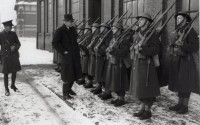
2nd Battalion - A Quarter Guard being inspected by the Secretary of State, Stanley Oliver, September 1939.
2nd Battalion
At the beginning of September the 2nd Battalion was stationed in Catterick, were they mobilized on the outbreak of War. Eleven days after the declaration war the battalion landed in France as part of the British Expeditionary Force. During the period referred to as ‘The Phoney War’ they guarded, trained and dug. The early part of the winter was spent in Nantes and St Nazaire. On the 2nd December together with the rest of the 5th Division they took up positions along the River Lys, near Armentieres. They later moved to another location near Bousbecque where they spent Christmas and New Year.
4th & 5th Battalions
When the war was declared the 4th and 5th Battalions were immediately embodied. Earlier in the year the Territorial Army had been doubled, and the 5th Wiltshire’s were formed by dividing the 4th into two. Both battalions were part of the 43rd Wessex Division and spent the rest of the year guarding ‘Key’ points in Wiltshire.
Once reinforcements and equipment had been received the Battalion was engaged in training and anti-invasion exercises in Scotland, followed by a winter based at Aintree Racecourse where there was more training and rescue work during the air raids on Liverpool and Birkenhead.
1940 The Second World War Continued
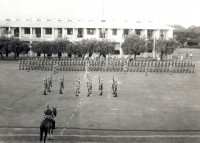
1st Battalion - Ferozeshah Day parade at Fort St. George, Madras, India in 1940.
1st Battalion
The 1st Battalion were still in India carrying out duties in costal defence.
2nd Battalion
The 2nd Battalion spent the first few months helping to construct the ‘Gort’ Line defences. In May they were moved to Amiens with a few to going to Norway, but this was cancelled because of the German invasion of the Low countries on the 10th May. The battalion’s first taste of action was on the 16th May when they came under shell fire and Aerial attack near Louvain. On the 18th the retreat started with the battalion acting as the rearguard. After they crossed the River Dendre the bridges were blown. By the 21st May the battalion were dug in on the River Scarpe in a very thin defensive line They spent the next few days under shell fire. Due to outflanking attacks by the Germans they later withdrew to Gavrelle, leaving straight away as that town was about to be captured by the rapidly advancing Germans. They we’re constantly on the move until the 27th May when they took up a position as the reserve battalion on the Ypres-Comines Canal. This action was necessary to allow other units to prepare the defences for the forthcoming evacuation at Dunkirk. When their time came they moved to Dunkirk where they formed part of a composite battalion and on the night of the 31st they embarked for England only 270 strong. They initially regrouped in Scotland with their time spent in training and anti invasion exercises. In October they moved to Liverpool where they continued training and assisting in rescue work during the air raids on Liverpool. They were carrying out this task at the end of the year.
4th & 5th Battalions
The 4th and 5th Battalion were continuing training and guarding ‘Key’ points until the German invasion in May when they moved to East Anglia, forming part of a mobile reserve in case of invasion. In November they moved to Kent where they joined General Montgomery’s X11 Corps. They were here at the end of the year.
1941 The Second World War Continued
1st Battalion
In 1941 the 1st Battalion returned to Bangalore and then to Lucknow in October, as part of the motorized Reserve Brigade for internal security duties. They were engaged in this role at the end of the year.
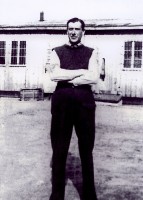
2nd Battalion - Private Arthur Lionel Grant in a Prisoner of War camp in Poland in 1941.
2nd Battalion
In spring 1941 the 2nd battalion with the remainder of the 5th Division moved to Northern Ireland because of an anticipated invasion of Eire. There they carried out further training which took up their time for the remainder of the year.
4th & 5th Battalions
In the early part of the year the 4th and 5th battalions were heavily engaged with costal defence, an invasion was still a possibility and raids and minor landings always a danger. They continued this task for the remainder of the year.
1942 The Second World War Continued
1st Battalion
In April the Battalion headquarters moved to Dinapore, on the Ganges with the remainder of the battalion being deployed over an area of 200 square miles in the Province of Bihar, engaged in keeping order at such places as Patna, Gaya, Bhagalpur and Rajauli. A detachment was also sent to Burma to assist in the evacuation. They were engaged in these duties at the end of the year.
2nd Battalion
In January 1942 the 2nd battalion moved to Surrey, having been selected to serve overseas. In March they embarked at Glasgow for an undisclosed destination. Whilst at Durban, South Africa they learned that their brigade was to take part in the assault landing on Madagascar, which was held by the Vichy French. They landed on the 6th May and took part in a forced march to Antisirane. The objectives were captured very fast and the troops re-embarked for the journey to India. On route they suffered from a malignant form of Malaria. On arrival in India they spent three months in quarantine and hard training after which they were on the move once again, this time to Persia to block the German advance through the Caucasus. By August they were under canvas near Zubair. They then carried out several moves training all the time. They were engaged in this duty at the end of the year.
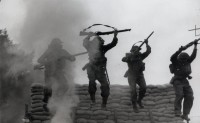
4th Battalion - soldiers on an assault course in preparation for D Day
4th & 5th Battalions
In February both the 4th and 5th Battalions moved to Dover where their training was intensified with the emphasis was now on ‘Battle Drill’. For the remainder of the year they trained very hard notably marching 10 day continuously on Exercise ‘Tiger’.
1943 The Second World War Continued
1st Battalion
The 1st Battalion were still engaged in ‘Internal security’ duties for the early part of the year. In September they were at last mobilized sailing from Madras for Chittagong where they joined the Fourteenth Army, for Jungle Warfare training.
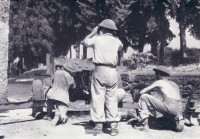
2nd Battalion - detachment of the anti-tank platoon waiting for a possible counter-attack beyond Palerno in Sicily in 1943.
2nd Battalion
The 2nd Battalion were sent to the Middle East in February. In order to achieve this the battalion had a tortuous journey, first by rail South west to Basra, then across the Tigris in lighters, on by rail again North east to Baghdad, and by road for over 500 miles over the desert into Syria ending up at Damascus. Further training took place in invasion tactics In June they moved to Suez carrying out the final training before embarking for the invasion of Sicily. They landed on the 10th July near Syracuse and advanced towards Florida and then captured Solarino. From this point they were constantly engaged in action where they played a leading part in the defence of the Simeto Bridgehead. In August the carrier platoon under the command of Sergeant MAW Rogers carried out a reconnaissance in force on Landolina Farm resulting in a heavy engagement with the Germans. In this action he was awarded the Military Medal. On the 12th August they were removed from the line to prepare for the invasion of Italy. They took part in the unopposed landing on Italy landing North of Reggio.
On the 7th September the battalion travelled by sea in Infantry Landing ships to Palmi and on landing encountered a strong enemy rear guard action. This was followed by a night march to Vibo Valencia, receiving their first news of the Italian surrender on the way. The battalion again reverted to sea transport and on the 14th September landed at Scalea. This was to support the Americans who had landed at Salerno. A number of hard marches followed and they paused to catch breath for the most of October. On the 31st October the battalion carried out a difficult night attack across the mountain slopes on Cantalupo, and then occupied Isernia. They spent Christmas at Calenza
4th and 5th Battalions
The battalion spent 1943 carrying out another strenuous year of training, including co-operation with the Royal Navy in a landing from the sea at Selsey Bill. There was also a lengthy Army Exercise called ‘Spartan’, this ended for the Wiltshire’s with an attack round Whipsnade Zoo, during which a tank penetrated the boundary fence and liberated a bison. Both battalions although territorials were now in a high state of readiness, they were fit, professional and ready for the task ahead.
1944 The Second World War Continued
1st Battalion
In the early part of 1944 the 1st Battalion was deployed to the Arakan. On the 4th February they were dug in at Bawli Bazar, on the North-west border of the Arakan, where they had their first contact with the Japanese. They continued to operate in this area being supplied by air. On the 17y February they were at Prinkhaung, and moved on to Yinboungyaung taking over from the 2nd/13th Frontier Force Rifles. They fought the Japanese Army at this location with a major engagement on a high part of the Mayu Range known as ‘Three Pimples’. This action and those that followed reduced the battalion to nearly half strength, and they were particularity short of Non Commissioned Officers. They moved south in March and took up a position on the Maungdaw-Buthidaung Road which was over- looked by the Japanese. Although static at this point they were constantly patrolling against the enemy. The next major action came in April when they moved into position for the proposed assault on Point 551. They carried out a number of frontal assaults on hills known as ‘Camel’ and ‘Hump’. At one point the Wiltshire’s were firing from the hip. A Japanese commander who was captured said’ You English bulldogs have got us this time’. The battalion then went on to capture ’Bullet’ and ‘Barrel’ two other pieces of high ground. All four objectives set for the battalion had been captured. They remained at these positions for several weeks under constant Japanese attack The battalion had lost about 200 officers and men killed and wounded and treble that number from malaria and other sicknesses. Eventually the Division including the battalion were withdrawn to India, moving to Rawapindi a healthy station in the North-west Punjab where they were at the end of the year.
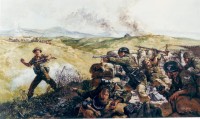
2nd Battalion - Sergeant Rogers winning his VC in Italy in 1943.
2nd Battalion
In January 1944 the 2nd battalion together with the rest of the 5th Division left the 8th Army and moved to the West to prepare for the crossing of the River Garigliano as part of the break out plan. The battalion and the rest of 13th Brigade were tasked to carry out a frontal assault on the Tufo Hills. On the 17th January they made a successful crossing of the river. Early enemy resistance was very quickly dealt with. The following day they achieved their aim in capturing the village of Tufo. They remained at this position for several days under constant German attacks. They later moved and occupied the Minturno ridge and the surrounding high points. The 21st and 22nd were very critical days for the Battalion. The hard pressed 94th German Division was reinforced by the 90th Light Division of Afrika Korps fame and the key ridge around point 201 changed hands four times before the battalion was finally driven off. The company that held this point was so heavily affected that it was not able to re-form for five months. .
On the 12th March they sailed from Naples and landed at Anzio, reliving another battalion in the gullies North of La Gogna. Here they dug in and faced the German 4th Parachute Division. After a number of sharp actions they were relieved returning to a rest area that was in fact under constant German bombardment. . At the beginning of April they took over a position known as ‘The Fortress’ and took over the trenches that in some cases were only 30 yards apart and both sides could hear each other talking. They remained on ‘Stand to; all night and tried to snatch sleep during the day. This war of attrition continued until the break out from the beach head on the 23rd May. The battalion part in the break out was to carry out a pre planned attack on Ardea. On the 3rd June they attacked and it was during this battle that the carrier platoon Sergeant, Sergeant Rogers MM attacked an entrenched German Parachute Division emplacement winning the Victoria Cross. He was killed in the same action. The Germans eventually withdrew and they continued the advance to Rome. In July the battalion sailed from Taranto for Palestine. They spent the rest of the year training near Nathanya, Damascus and Gaza.
4th & 5th Battalions
The early part of 1944 was spent containing the hard training for the invasion of France. They were not destined to land on the 6th June but later with the rest of the 43rd Division who were designated as ‘Break out’ troops. They embarked on the 18th June landing at Arromanches. After landing they got organised and their first taste of action took place on the 26th when the 4th Battalion cleared the villages of Bouliesse Le Perron and Marcelet. What followed was prolonged fighting in very difficult country. They took up a position in an area known as ‘The Oden Box’ followed by a sustained attack on Hill 112 which was strongly held by the 10th SS Panzer Division, a tough, experienced and battle hardened division. This was very much a West Country ‘battle with both battalions fighting alongside their comrades in the Dorset’s and Duke of Cornwall Light Infantry. (All these units are now part of ‘The Rifles) On the 22nd July they took part in the capture of the village of Maltot. On the 30th July the 43rd Wessex Division was transferred to the XXX Corps and there in the Bocage country captured Bois du Homme, near Caumont, On the 4th August both battalions played a significant part in the capture of Mont Pincon. In August they crossed the River Seine, the 4th Battalion providing support to the 5th Battalion who carried the main assault. Under a smoke screen they embarked in the assault boats and set off. Half way across they hit a submerged sandbank, and at the same time the wind dispersed the covering smoke. The German Machine gunners then opened up and only one of the original eight boats survived. One boat reached the far bank and effectively formed the bridgehead for the following troops. On the 13th September they left the Seine and headed North-East where they were destined to take part in the advance on Arnhem , they fought at Nijmegen and the area enclosed by the Waal and the lower Rhine between Nijmegen and Arnhem know as ‘The Island. From October onwards they fought no major battles but were in constant contact with the enemy. By Christmas this year the 5th were in Tongres, and the 4th in Millen, Belgium.
1945 The Second World War Continued
1st Battalion
The battalion started the year in Rawalpindi, leaving there in March to go to Razmak remaining there for nine months. They celebrated both the Surrender of the Germans in May and the Japanese in August. They continued the tasks so familiar to the old North West Frontier hands of showing the flag, keeping the roads open and, having the occasional gun battle with the locals. In December the returned to Rawalpindi with the honour of having been the last British Battalion to serves at Razmak.
2nd Battalion
They started the year at Nathanya in Palestine and in January together with the rest of the 5th Division they returned to the Anzio Bridgeheads. In March they went to Belgium where they joined the 21st Army Group. They drew new equipment and prepared for action. In April the battalion moved up to the Goch area, later crossing the Rhine at Zanten where their comrades in the 4th and 5th Battalions had fought only a few weeks before. . They advanced to Uelzen where they cleared a certain amount of opposition before reaching the West bank of the Elbe. On the 30th April near Luneburg they crossed the river and early the following morning led the breakout into the village of Grosse Gronau. This was the battalion’s final action of the war. They were at Lubeck on the 8th May when hostilities ceased. On the 1st July they moved to Einbeck, wwest of the Harz mountains where they settled down to occupation duties. They ended the year at Bothfeld, on the outskirts of Hanover.
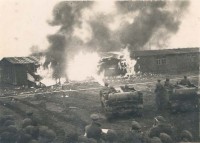
5th Bn The Wiltshire Regiment – The Carrier Platoon using their flame throwers to set fire to the Belsen Concentration Camp due to the outbreak of Typhus.
On the 11th January both battalions both to the Geilenkirchen Sector where they took part in an attack on the 22nd. Both battalions attacked in Kangaroos, armoured troop carriers. After a lot of shelling they took the village of Straeten, with some of the men at such close quarters they were firing from the hip. Many prisoners were taken. On the 8th February the battalions were in Nijmegen and from there they led the assault on Cleve where they took part in a major battle. After captured the town they moved to the high ground beyond and dug in countering a number of attacks from the 115 and 116 Panzer Divisions. They occupied Cacar on the 27th February, and on the 8th March attacked Luttinggen.. By the 27th March they had crossed the Rhine and moved fast towards Bremen. On the 26th April they started their attack on the residential area of Bremem their objective being the Burgher park, the Hyde Park of Bremen. Major BGP Pope of the 4th Battalion captured two German generals, with all their staff officers, a Vice Admiral and the Nazi Bishop of Bremen.
As they were about to assault Bremerhaven news came through that the war was at and end. They remained in the area till the end of the year. Following the surrender of German troops in Europe in May 1945 the 4th Wiltshire’s were selected to administer the concentration camp at Belsen – an experience that was to mark those involved for the rest of their lives. The carriers of the battalion were used to burn down many of the former inmate’s huts. Battalion Headquarters (4th Wilts) and 'HQ' Company moved into a nearby former SS barracks, with the 'Wasp' section of Support Company helping with the destruction by fire of the verminous and germ-ridden shacks. The name of 'Belsen' with its evil connotations was replaced by 'Hohne' (a nearby hamlet).
For a more detailed account of what each battalion did during the Second World War go to the War Diaries section on this web site
1946 The Post War Years
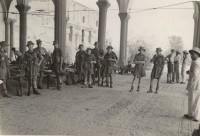
1st Battalion - soldiers Keeping The Peace in Lahore, India 1946.
By July 1946 both the 4th and 5th Battalions has been disembodied. However, the 4th re-formed in May 1947 and in December that year took part in the ceremony to receive the Freedom of Salisbury.
In India in the 1st Battalion spent its last months in the country on peace keeping duties in Calcutta, Jullundur, Amritsar and Lahore attempting to keep the warring factions apart prior to the British withdrawal before sailing for England in August 1947. The post war years saw the start of the scaling down of the British Army which reduced each Regiment of the Line by one Battalion by amalgamating the 1st and 2nd Battalions. The 1st Battalion was reduced to a cadre as men returned to civilian life and were not replaced, and the final small nucleus joined the 2nd Battalion in Germany. The amalgamation ceremony took place at Krefeld, BAOR, on 10 January 1949 to form the 1st Battalion the Wiltshire Regiment.
The following year the Battalion returned to England and training started for a deployment to Malaya, but en route the destination was changed to Hong Kong. Arriving in China in September 1950, the Battalion spent three years there, despatching frequent drafts to join units fighting in Korea.
In 1953 HRH the Prince Philip Duke of Edinburgh became Colonel-in-Chief of the Wiltshire Regiment. A peaceful but energetic interlude in England in 1954-5 as the Demonstration Battalion of the School of Infantry at Devizes,
1956 Cyprus
The tour as Demonstration Battalion was followed by a strenuous three years in Cyprus on active service against EOKA terrorists being responsible for the same part of the island throughout their tour; an area covering the Kyrenia Mountain Range and the coast in the extreme North, except fro the North-eastern peninsula. Terrorists, who strike in the dark and the back, and from ambush are some of the most difficult of enemies to contend with. and in the first fifteen months of their tour until there was a truce, the Wiltshires were involved in over fifty incidents with bombs and mines, and many ambushes and armed assaults. On the outskirts of Kyrenia two of the Battalion’s vehicles were ambushed, which resulted in a lady of the Women Voluntary Service and two men being killed, as well as two wounded. In early 1957 Eoka called a truce but the work of Internal Security could never be relaxed. The propaganda campaign increased with its posters and slogans. The political situation deteriorated with the breaking point coming in the heat of June 1958.
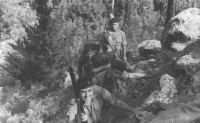
1st Battalion - a Cordon and Search operation in the Kyrenia Range of mountains in Cyprus in 1959.
As trouble erupted between the Greeks and Turks in Nicosia. In November 1958 the battalion was directly responsible for the death in 1958 of Christoforou Kyriakos Matsis who had been a target for the battalion for most of their tour.
While serving in Cyprus the news came that yet more army reorganisation meant a merger with the Royal Berkshire Regiment. This Regiment was also serving in Cyprus at the same time so a lot of cross postings followed to ensure a smooth merger.
1959 UK and Amalgamation
In February 1959 the Wiltshirs sailed home and on arrival in England went to Albany Barracks on the Isle of Wight. On 2nd May they tropped the old Colours of the 1st and 2nd Battalions and two days later these were laid up in Salisbury Cathedral. On 16th May the Regiment received theFreedom of Swindon and then prepared for the Amalgamation that took place on 09 June 1959 at Albany Baracks.
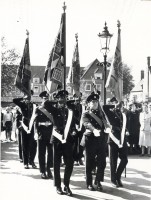
1st Battalion - the Colour Party marching into Salisbury Cathedral Close prior to the Laying-up of Colours in Salisbury Cathedral 1959.